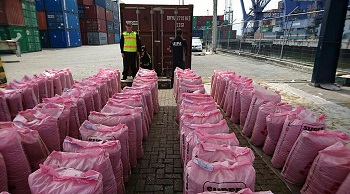Ecuador has seized around 10 metric tons of cocaine at the Guayaquil port in the space of a few days, suggesting that the country may be growing in importance as one of Latin America’s key drug transit hubs.
Ecuadorean police made their biggest cocaine seizure of the year on December 2, when officials intercepted 7.5 metric tons of the drug in Guayaquil. The cargo had been destined for Honduras and was concealed in a container that should have contained 400 kilograms of shrimp feed.
On November 29, Interior Minister Diego Fuentes announced the seizure of 2.5 metric tons of cocaine hydrochloride (HCl) in a banana shipment headed to the Netherlands, also in the Guayaquil port. The bust followed three months of investigations. Eight people were arrested.
The following day, Fuentes told the press that security forces had seized 81.15 metric tons of total drugs so far this year, surpassing the 72 metric tons of drugs seized over the same period in 2015. Of this year’s seizures, 68.45 metric tons correspond to cocaine HCl, higher than the 59 metric tons of crystalized and base cocaine intercepted over the whole of 2015, according to US figures.
InSight Crime Analysis
Ecuador’s seizures have been rising over the past few years. The country intercepted nine metric tons more cocaine and coca base in 2015 than in 2014, according to US statistics, and the difference this year may be even steeper. The US State Department reports that maritime seizures have also followed this rising trend, “despite the Ecuadorean Navy’s lack of resources.” This suggests that Ecuador’s role as a Pacific transit hub for drugs heading to consumer nations such as the United States and European countries may be growing in importance.
SEE ALSO: Coverage of Ecuador
While Ecuador itself does not produce any significant amount of cocaine, it is sandwiched between the world’s two main producers of the drug — Colombia and Peru — and receives shipments from both ends.
Central to this dynamic is Guayaquil, one of the continent’s most important ports and an exit point for illegal drugs that has long been under the influence of transnational organized crime. The volume of legal traffic through the port greatly facilitates this movement, as only 20 percent of containerized exports are inspected, according to the US State Department.
Guayaquil is also a meeting place for international criminal groups and a storage center for drugs. Indeed, seizures of the size seen recently are unusual, suggesting that a number of smaller drug loads were pooled together by different suppliers.
There are indications that the Sinaloa Cartel is operating from this port city, and past seizures have been linked to Colombia’s most powerful criminal organization, the Urabeños.

